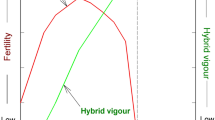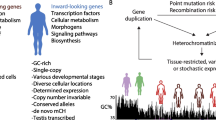Abstract
A biological explanation for the dependence of genome-wide mutation-rate variation on local base context is now becoming clearer. The proportions of G + C relative to A + T—expressed as GC%—is a species-specific DNA character. The frequencies of these single bases (1-mers) correlate with frequencies of corresponding oligonucleotides (k-mers) that are more-sensitive indicators of species specificity. Thus, when k = 3 there are 64 possible trinucleotide sequences and a GC%-rich species has a high frequency of GC-rich 3-mers (e.g., GCG, CGG, CGC, etc.). Closely related species have similar k-mer patterns. For distantly related species, even if happening to have the same GC% values, k-mer patterns are widely discordant. Conventionally, a base substitution mutation is viewed as a chemical 1-mer phenomenon. However, the selective difference by which the corresponding mutation is scored usually relates to context (i.e., to the k-mers within which a 1-mer mutation is embedded). Thus, an A to U codon mutation in sickle cell anemia (GAG to GUG), rather than attracting an anticodon in a structural loop of glutamate tRNA, pairs with the more complementary anticodon loop of valine tRNA. Likewise, a recent statistical analysis of genome-wide mutation-rate variation supports the view that a failure of discordant DNA loops to pair at meiosis can initiate and/or sustain the speciation process. Such disharmony among base patterns may have unknowingly been hinted at by geneticist William Bateson who invoked a music metaphor when considering speciation mechanisms.
Similar content being viewed by others
References
Aggarwala V, Voight BF (2016) An expanded sequence context model broadly explains variability in polymorphism levels across the human genome. Nat Genet 48:349–355
Bateson W (1894) Pitch theory of reproductive cells. https://wayback.archive-it.org/7641/20191111141539/http:/post.queensu.ca/~forsdyke/bateson8.htm (see also Supplementary material 1, 2, 3)
Benzer S (1961) On the topography of the genetic fine structure. Proc Natl Acad Sci USA 47:403–415
Bize A, Midoux C, Mariadassou M, Schbath S, Forterre P, Da Cunha V (2021) Exploring short k-mer profiles in cells and mobile elements from Archaea highlights the major influence of both the ecological niche and evolutionary history. BMC Genomics 22:186
Blake RD, Hess ST, Nicholson-Tuell J (1992) The influence of nearest neighbors on the rate and pattern of spontaneous point mutations. J Mol Evol 34:189–200
Bossi L, Roth JR (1980) The influence of codon context on genetic code translation. Nature 286:123–127
Bozdag GO, Ono J, Denton JA, Karakoc E, Hunter N, Leu J-Y, Greig D (2021) Breaking a species barrier by enabling hybrid recombination. Curr Biol 31:R161–R185
Brbić M, Warnecke T, Kriško A, Supek F (2015) Global shifts in genome and proteome composition are very tightly coupled. Gen Biol Evol 7:1519–1532
Chargaff E (1951) Structure and function of nucleic acids as cell constituents. Fed Proc 10:654–659
Cock AG, Forsdyke DR (2008) “Treasure your exceptions.” The science and life of William Bateson. Springer, New York
Crick F (1971) General model for the chromosomes of higher organisms. Nature 234:25–27
Eguchi Y, Itoh T, Tomizawa J (1991) Antisense RNA. Ann Rev Biochem 60:631–652
Forsdyke DR (1996) Different biological species “broadcast” their DNAs at different (G+C)% “wavelengths.” J Theor Biol 178:405–417
Forsdyke DR (2014) Implications of HIV RNA structure for recombination, speciation, and the neutralism-selectionism controversy. Microb Infect 16:96–103
Forsdyke DR (2016) Evolutionary bioinformatics, 3rd edn. Springer, New York
Forsdyke DR (2017a) Speciation: Goldschmidt’s chromosomal heresy, once supported by Gould and Dawkins, is again reinstated. Biol Theor 12:4–12
Forsdyke DR (2017b) Base composition, speciation, and why the mitochondrial barcode precisely classifies. Biol Theor 12:157–168
Forsdyke DR (2019a) Success of alignment-free oligonucleotide (k-mer) analysis confirms relative importance of genomes not genes in speciation. Biol J Linn Soc 128:239–250
Forsdyke DR (2019b) Hybrid sterility can only be primary when acting as a reproductive barrier for sympatric speciation. Biol J Linn Soc 128:779–788
Forsdyke DR (2020) Revisiting George Romanes’ “physiological selection” (1886). Biol Theory 15:143–147
Forsdyke DR (2021) Neutralism versus selectionism: Chargaff’s second parity rule, revisited. Genetica 149:81–88
Forsdyke DR, Bell SJ (2004) Purine-loading, stem-loops, and Chargaff’s second parity rule: a discussion of the application of elementary principles to early chemical observations. Appl Bioinform 3:3–8
Forsdyke DR, Mortimer JR (2000) Chargaff’s legacy. Gene 261:127–137
Josse J, Kaiser AD, Kornberg A (1961) Enzymic synthesis of deoxyribonucleic acid. VIII. Frequencies of nearest neighbor base sequences in deoxyribonucleic acid. J Biol Chem 236:864–871
Kleckner N (1997) Interactions between and along chromosomes during meiosis. Harvey Lect 91:21–45
Kleckner N, Weiner BM (1993) Potential advantages of unstable interactions for pairing of chromosomes in meiotic, somatic and premeiotic cells. Cold Spring Harb Symp Quant Biol 58:553–565
Lao PJ, Forsdyke DR (2000) Thermophilic bacteria strictly obey Szybalski’s transcription direction rule and politely purine-load RNAs with both adenine and guanine. Genome Res 10:228–236
Liu Z, Samee AH (2021) Mutation rate variations in the human genome are encoded in DNA shape. BioRxiv. https://doi.org/10.1101/2021.01.15.426837
Morozov AA (2017) k-mer distributions of aminoacid sequences are optimised across the proteome. BioRxiv. https://doi.org/10.1101/190280
Newman SA (2007) William Bateson’s physicalist ideas. In: Laubichler MD, Maienschein J (eds) From embryology to evo-devo: a history of developmental evolution. MIT Press, Cambridge, pp 83–107
Paz A, Kirzhner V, Nevo E, Korol A (2006) Coevolution of DNA interacting proteins and genome “dialect.” Mol Biol Evol 23:56–64
Rogerson AC (1991) There appear to be conserved constraints on the distribution of nucleotide sequences in cellular genomes. J Mol Evol 32:24–30
Röhling S, Linne A, Schellhorn J, Hosseini M, Dencker T, Morgenstern B (2020) The number of k-mer matches between two DNA sequences as a function of k and applications to estimate phylogenetic distances. PLoS ONE 15:e0228070
Shepherd JCW (1981) Method to determine the reading frame of a protein from the purine/pyrimidine genome sequence and its possible evolutionary justification. Proc Natl Acad Sci USA 78:1596–1600
Sueoka N (1961) Compositional correlation between deoxyribonucleic acid and protein. Cold Spring Harb Symp Quant Biol 26:35–43
Watson JD, Crick FHC (1953) A structure for deoxyribose nucleic acid. Nature 171:738–740
Zickler D, Kleckner N (2015) Recombination, pairing, and synapsis of homologs during meiosis. Cold Spring Harb Pers Biol 7:a016626
Author information
Authors and Affiliations
Corresponding author
Additional information
Publisher's Note
Springer Nature remains neutral with regard to jurisdictional claims in published maps and institutional affiliations.
Supplementary Information
Below is the link to the electronic supplementary material.
Rights and permissions
About this article
Cite this article
Forsdyke, D.R. Complementary Oligonucleotides Rendered Discordant by Single Base Mutations May Drive Speciation. Biol Theory 16, 237–241 (2021). https://doi.org/10.1007/s13752-021-00380-z
Received:
Accepted:
Published:
Issue Date:
DOI: https://doi.org/10.1007/s13752-021-00380-z




